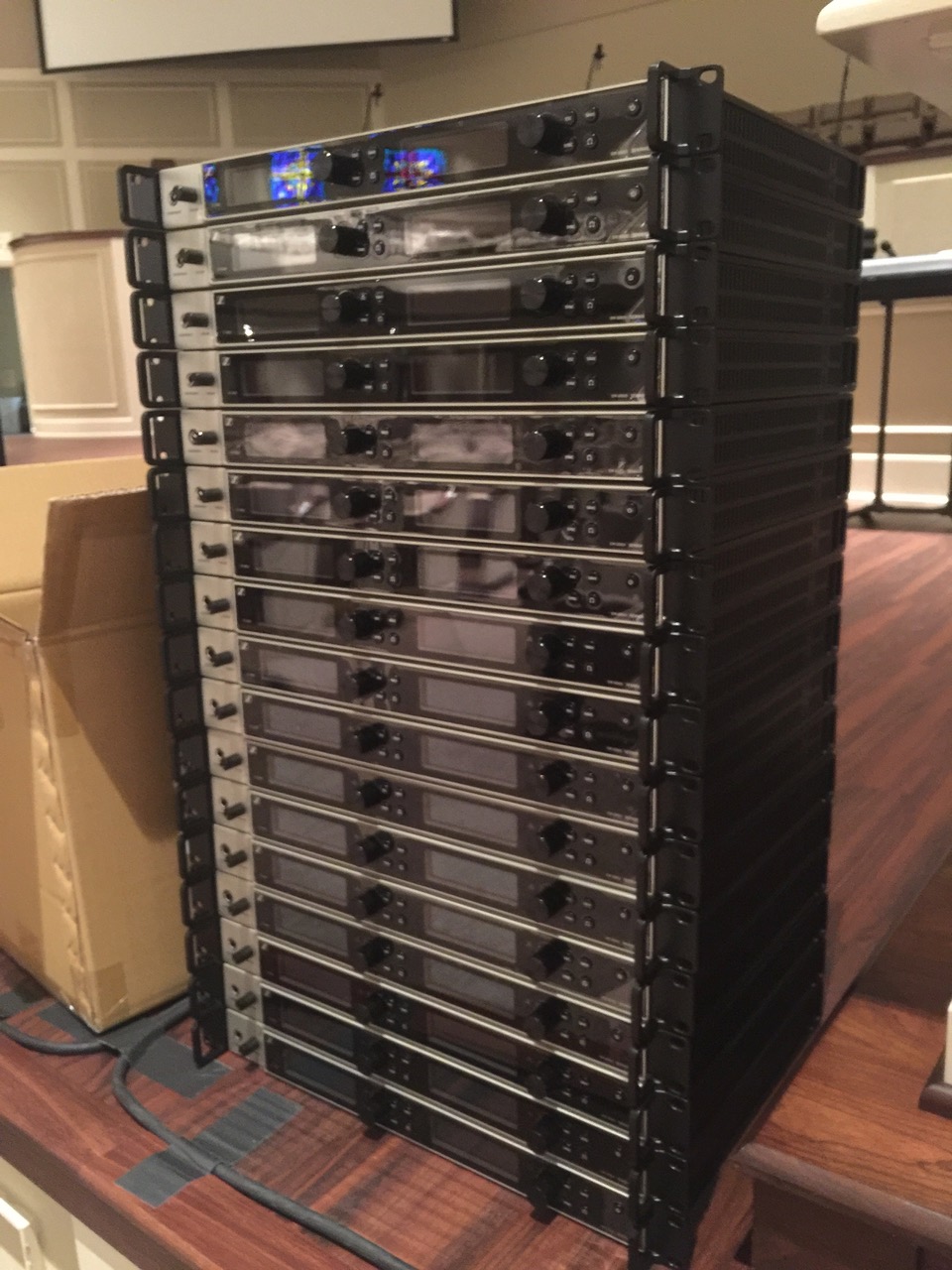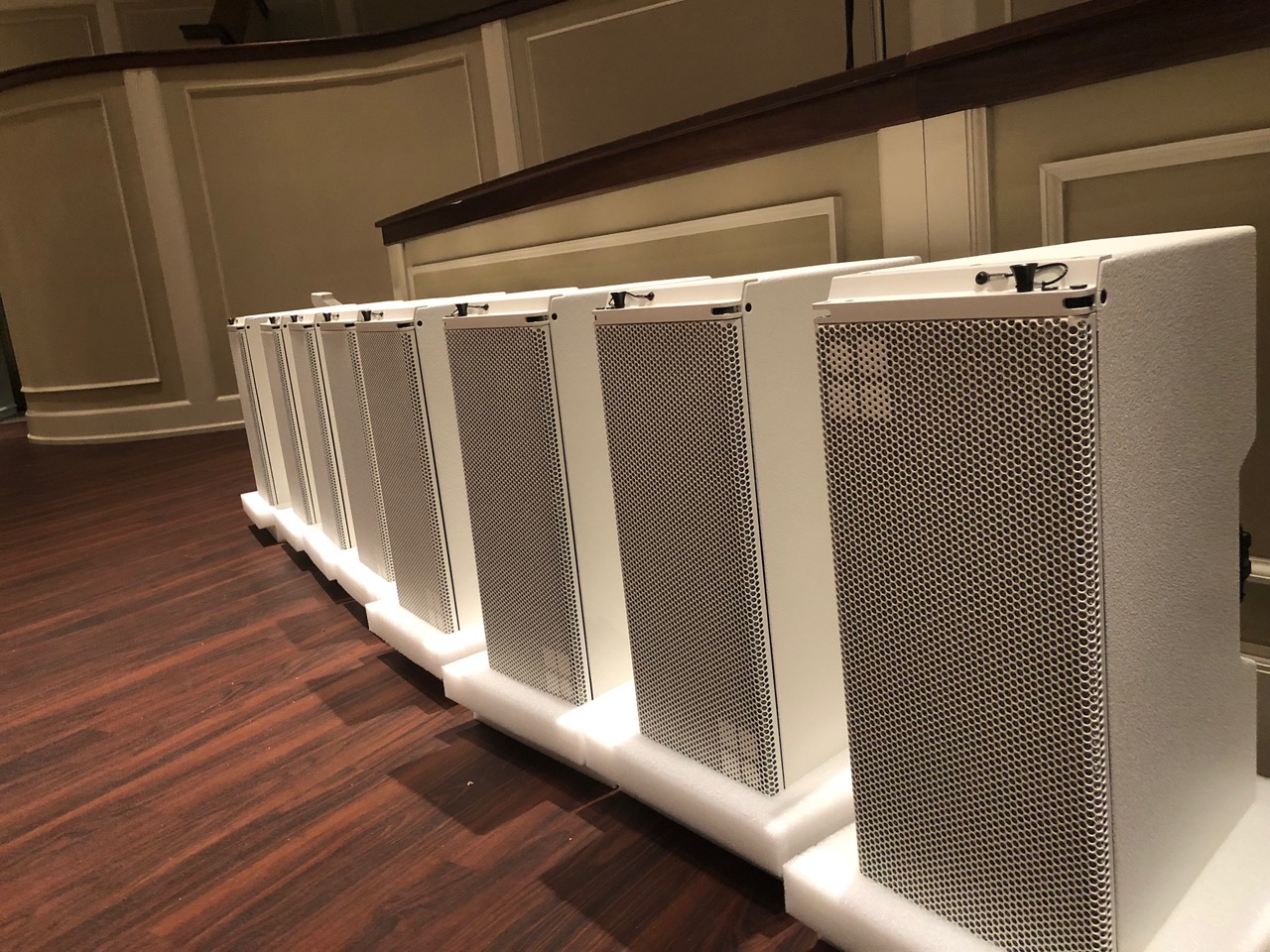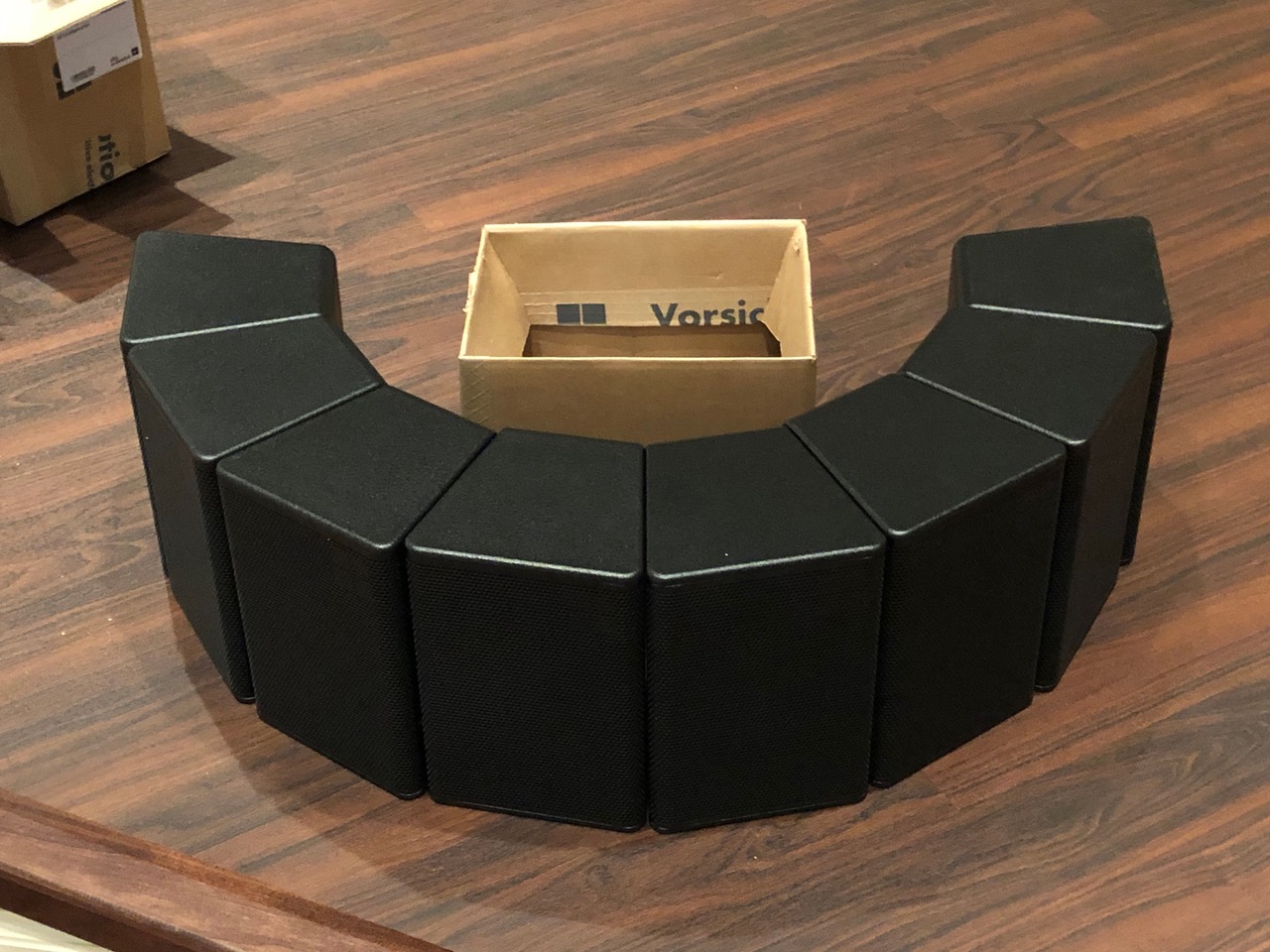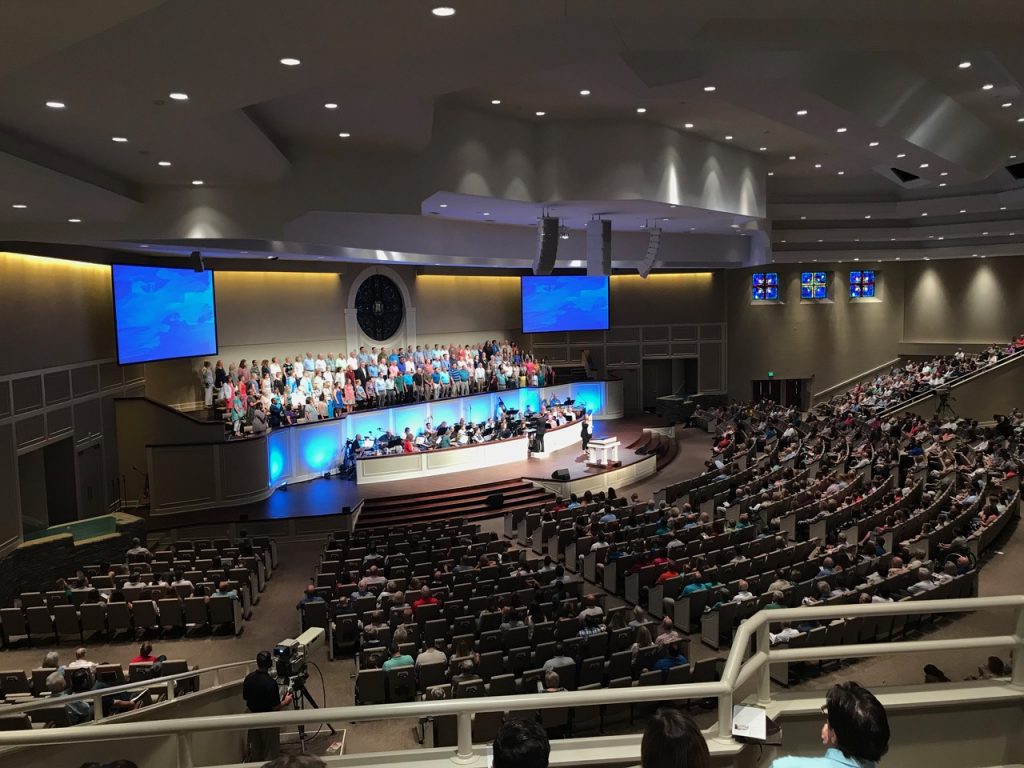Sound reinforcement is inarguably the most important factor in the AV equation for houses of worship (HoWs). Although video and lighting technology can help create a deeper, more engaging worship experience for congregants, and certainly many HoWs employ these technologies, the worship experience is still ultimately about expressing a message of faith—and that message is mostly conveyed through spoken word and music. For this reason, maintaining an up-to-date audio system is a key concern for many HoWs.
The importance of high-quality audio is not lost on the leadership of Hoover AL’s Hunter Street Baptist Church. According to Brandon Headley, Hunter Street’s Worship Production Director, “Audio is a tool that we utilize for the spreading of the gospel in our ministry and worship services. The spoken word of God is the primary means of discipleship, evangelism and instruction in our worship services. Our audio systems and technologies are paramount in providing a way for what is being said, sung and taught to be delivered to the people in participation of our worship services in a clear and non-offending way.”
Services at Hunter Street feature spoken-word segments, as well as a variety of musical acts that perform songs from different genres. Headley explained, “We have a seven-member rhythm section that plays every week. Our 25-member orchestra is made up of all kinds of people from our congregation, and they play 46 weeks out of the year. Our choir is a group of 150-plus that helps lead worship 46 weeks out of the year, and the vocal team is a group of people that come out of that choir group.” He continued, “Our style of music would be called ‘blended’ by most places. We try not to be tied to descriptive words, but, rather, choose from a diverse palette of music that showcases all the different types of music that God has created. There might be a week where we have a musical selection that would be considered ‘high church.’ We might follow that up with an acoustic, folksy song, and then follow that up with a ‘traditional’ Southern Baptist hymn. We also have our age-graded choirs—first through 12th grades—to help lead in worship on different Sundays throughout the year.”
Hunter Street’s campus includes the main worship center, as well as a chapel and additional rooms dedicated to youth ministry. “We are currently running three Sunday services at Hunter Street,” Headley said. “The first service at 8am happens in our chapel, and the other two services happen in our worship center. Our average weekend attendance is 2,600. Even though these three services happen in two different venues, they are programmed with the same message and songs.”
Hunter Street, like many modern churches, features video technology and theatrical lighting, but the venue’s audio system was the focus of a recent renovation project. Simply put, Hunter Street recognized the need to replace its aging audio system with something a bit more contemporary—and a lot more reliable. “The previous audio system at Hunter Street had been in use for almost 20 years in the worship center,” Headley explained. “To say that it had been well utilized would be an understatement.” He continued, “The age of the system, combined with poorer technology, was not allowing us to be able to deliver a good audio experience for the people who participate in our worship services. When I arrived at Hunter Street almost five years ago, there was a need for the system to be replaced because of poor coverage and the beginning signs of the system [showing its age].”
Hunter Street enlisted the services of Spectrum Sound (Nashville TN, www.spectrumsound.net) for the audio upgrade. The Spectrum Sound team included Systems Integration Sales Manager Ken DeBelius, Project Manager and Crew Foreman Zeb Chamlee, Lead Installer Rod Hester, and Installers Mike Thamann, Ryan Stotts, John Matthias and Ray Park.
“Spectrum Sound had an ongoing relationship with Brandon and several of the staff at Hunter Street for probably about the last 10 years from a previous ministry,” DeBelius explained. “The Hunter Street staff knew all too well that the audio system in the main worship center had poor coverage, and the tonal quality wasn’t great. Gain before feedback on speech was a principal concern of Brandon’s. With their old PA, there was a lot of uncontrolled energy from the system that spilled onto the stage area, which made the amplified speech very reverberant sounding; that was detrimental to overall speech intelligibility. Attempts by others to ‘retune’ the system were [made] several times over the years, with no real resolution. Eventually, a total system renovation was planned for, with preliminary budgets put into place.”

Spectrum Sound began planning a new sound system with Hunter Street in 2016. However, because of the reality of tight budgets in the worship market, the project was put on hold while funds were allocated; until a budget was set, the church had to “make do” with the existing system. However, a spate of system failures in the main worship center’s speaker cluster in late 2017 made it clear that an upgrade would have to be completed sooner rather than later.
“Working with Ken and the team at Spectrum, we began to get a realistic view of what we needed to be looking at, financially, when it came time to replace our system,” Headley explained. “We had a demo system in December 2016 that was a very close representation of the system that would be implemented when the decision was made to purchase. But, in December 2017, wehad combined failures that prompted a phone call to Ken and the team to begin the process of replacing our main audio system in the winter of 2018.”
According to DeBelius, the timing of the system failure necessitated a quick, temporary fix; indeed, Spectrum Sound had to rely on its rental inventory to keep Hunter Street in service while the final system was completed. “On a Monday morning in early January 2018, I received word from Brandon that their system was dying, and it was time to replace it,” DeBelius recalled. “But even though an initial plan was in place, final engineering details were not completed, and not one piece of gear had been ordered. And they had a service in less than a week!” He continued, “Fortunately, with Spectrum’s in-house production rental inventory, we were able to get them up and running for the next few months while the rest of the install details were completed and equipment was ordered.”
The upgraded system was installed in stages, and the rental equipment was used until permanent solutions were installed. Ultimately, Hunter Street’s new sound system was completed and installed by this past April. The scope of the project included upgrades to the main worship center, as well as renovation of one of the youth rooms. The new sound system in the main worship center includes a DiGiCo SD5 mixing console and accompanying infrastructure; d&b audiotechnik amplifiers and Y Series line arrays; additional d&b fill speakers, subs and monitors; Waves signal processing; and a Dante backbone.
DeBelius described how the use of rental systems as a temporary solution enabled a manageable, methodical approach to the worship center upgrade. “With the temporary system in place, and the engineering details finalized, Spectrum was able to carefully deploy the new system in logical stages: the DiGiCo fiber infrastructure for the SD5 was installed first, and the old PA was dismantled and pulled down,” he said. “Their existing amplifier racks were gutted, and then repurposed for the new d&b amplifiers’ pre-wiring, along with the DiGiCo SD-Racks. Then, their [preexisting] Yamaha PM1D console was taken out of service, and the DiGiCo SD5 was brought online in mid-February.” He added, “Because the church chose white boxes for the main d&b arrays, this added a bit of extra time for getting the loudspeakers from the factory in Germany to the US. [Those] were the last pieces swapped out for the temporary system.”

The process of installing the new system in stages, while relying on rental equipment to fill the gaps, also allowed Spectrum Sound to more easily make sense of the old system’s inputs and infrastructure, which had been complicated by multiple modifications. “Typical of most renovation projects, their existing system had evolved over the years. And when I say ‘evolved,’ I don’t mean evolved into something better,” DeBelius quipped. “What might have been a nice, clean and organized install decades ago slowly, but surely, morphed into a tangled bit of unlabeled wiring, clutter, and abandoned hardware and equipment. Sorting out their existing stage infrastructure of microphone lines, monitor lines and video ties—which were not replaced—was certainly a challenge for the install team.” He added, “And, of course, whatever was worked on during the week needed to be in workable condition for the upcoming weekend—but this is what we do. Having the temporary rental system in place and swapping it out as subsystems were put online made the process fairly logical and orderly.”
The first order of business was installing the infrastructure for the new SD5 console, which included three SDRacks and a multimode fiber package. “The three SD-Racks are located in the equipment room backstage,” Debelius described. “This allows short analog runs from their existing stage pockets to the SD-Racks. These are loaded with 20 ADC cards, giving them 160 mic/line inputs. The fiberoptic system is exclusively for the SD5 and the SD stage racks; this is common multimode fiber for the Optocore protocol used to transport audio channels for the DiGi- Co SD5 system.” He added, “Because this is a permanently installed system, we used the more economical ‘ST’-style fiber connectors, rather than the robust ‘HMA’ style that would be more suitable for a portable system. We also installed a simple fiber patchbay in the equipment room so that, if needed, additional equipment can be inserted into the fiberoptic Optocore loop, or for easier troubleshooting and testing.”
Spectrum Sound then repurposed the existing amplifier racks and installed the d&b amplifiers, which include seven 30Ds and one 10D. “The 10D amplifier drives the front-fill loudspeakers, while the 30Ds power everything else,” DeBelius said.
Once the infrastructure for the SD5 console was in place, Spectrum Sound installed the console itself. The church was originally considering another console during the demo stage of the project in 2016, but that console proved not to be an ideal fit for Hunter Street’s workflow needs. “With all the diversity of choices for high-end mixing consoles today, it really all comes down to personal preferences and how they fit into one’s overall mixing workflow,” DeBelius explained. “During the rental in 2016, another well-respected, large-format console was demonstrated on site for Brandon. The console sounded amazing sonically, but it was eventually rejected. [It wasn’t] because it wasn’t a good console, but, rather, because the workflow just didn’t fit what Brandon was looking for. A DiGiCo SD5 was eventually arranged through Spectrum and Ryan Shelton from DiGiCo, and Brandon instantly felt comfortable with it. That, plus the input capability of the SD5 fit with Hunter Street’s input need of well over 150 channels.”
One of the main priorities of the upgrade was replacing the failing speaker cluster with more modern line arrays. Spectrum Sound specified d&b Yi12 arrays for this purpose. “The Y Series was demonstrated to Hunter Street in 2016, when they used it for their Christmas season,” DeBelius shared. “That, coupled with Brandon having had great experiences with d&b, made the choice very straightforward.” The main system uses two eight-box arrays in a mono configuration.
Spectrum Sound used d&b’s ArrayCalc software to model the space. “Using a combination of CAD drawings supplied by Hunter Street [and] onsite measurements, a 3D model of the seating planes was constructed virtually in ArrayCalc,” DeBelius described. “This allows the designer to optimize various loudspeaker scenarios with detailed renderings of direct-field coverage. The worship center was already pretty well controlled acoustically, having had acoustic treatment installed during its last architectural renovation. With the controlled and reliably predicable polar pattern of the d&b product, there was no need for further acoustic work.” He added, “In addition, the Array Processing (AP) function of the d&b loudspeakers was employed; this further optimizes acoustic energy from the arrays, giving better direct-to-reverberant levels to the listeners than an ordinary, non-AP’d line array. The aural result is quite upfront and listenable, and, even with low-amplified levels, speech is more intimate sounding, without a lot of accompanying ‘room sound’ to muddy up the vocals.”
Hunter Street’s main worship center is a rather wide, but not particularly deep, room that seats 2,000; that made determining the ideal placement of the line arrays a challenge. “With this wide of a room configuration, one of the main challenges for a loudspeaker design, in my opinion, besides the obvious goal of smooth coverage throughout the room, is how to maintain natural imaging and intimacy,” DeBelius explained. “By that, I mean drawing the listener’s attention naturally to the stage, where the sound subjectively appears to be coming from where you are seeing it.” He continued, “As humans, we are quite adept at sensing acoustic directionality, and, in a lot of poor designs, it’s quite unnatural to one’s sensation to see a source visually, but to hear it coming from somewhere else. If I were to deploy a widely spaced left and right array in this room, I could get decently smooth coverage with appropriate fills, but the imaging across the seating would be very inconsistent. Furthermore, obtaining consistent stereo imaging in this kind of room is simply out of the question, as maybe 20 percent of the listeners might hear much stereo effect.”
He added, “All that is to say, for the design at Hunter Street, I chose left and right main arrays, but spaced somewhat closer toward the center of the room, and splayed outward to get the needed horizontal coverage and source imaging back toward the center of the stage. Although, admittedly, the main arrays are configured and wired to send left and right in stereo from the DiGiCo SD5 mixing console, the system is intended as mono.”
The sound-reinforcement system also includes several d&b fill speakers, including two Yi7Ps and eight 5S units. “The Yi7P is the point-source version of the Y Series line-array module,” DeBelius described. “These are used as side fills, basically covering the left and right tiered wings of the auditorium going up to the balcony.” He continued, “The 5S loudspeakers are the front fills located at the lip of the downstage edge. Even though the main flown arrays provide good coverage from the front row to the back of the auditorium, these fills gently ‘bend’ the imaging back to the stage for the front-row seating.”

Spectrum Sound also installed new d&b subs, with four Yi-SUBs flown above the stage, and six 27S units located under the stage. “The system at Hunter Street uses both flown and under-stage floor subs,” DeBelius explained. “This is the best of both worlds because, while subs on the ground couple well and are reinforced by the half-space from the floor, they tend to overpower those in the front rows, while not projecting as well into the rear of the room—especially when you have a balcony. Therefore, I also like to use flown subs to get smoother coverage into the rest of the room.” He elaborated further, adding, “Both the Yi-SUBs and the 27S subs are inherently cardioid. The cardioid behavior further helps with getting rid of as much reverberant, or wasted, energy as possible.”
Stage monitors include six M6 wedge monitors and three Ti10L flown monitors. “The M6 monitors are traditional wedge monitors, and are used portably on the stage where needed,” DeBelius said. “The Ti10Ls are used for the flown choir monitors. Suitable choir monitoring was an issue that Hunter Street fought unsuccessfully for some time. Like the main seating, the choir loft is also very wide and shallow—almost the entire width of the stage. Besides their old choir monitors not covering well, they spilled a lot of energy to the rear upstage wall, which directed a lot of muddy acoustic reflection back into the house. The mix engineer was in a no-win situation: As these monitors were turned up loud enough for the choir to hear, the house audio suffered from that excessive backwash.” He continued, “As a proof of concept, the Ti10Ls were temporarily deployed along with the main arrays in 2016. For the first time, the choir could hear at reasonable levels, without polluting the house mix with extra reverberant energy.”
A Focusrite RedNet D64R Danteto- MADI interface connects the SD5 console to Hunter Street’s preexisting Allen & Heath ME personal monitor system. “The RedNet D64R converts MADI from the SD5 surface into Dante, which then interfaces and feeds an AH-M-Dante-A card for the ME personal monitoring system,” DeBelius described.
Signal processing is handled via an External Extreme DiGiCo/Waves Package, which includes a C6 multiband compressor and a MultiRack SoundGrid license, as well as an SG Live plugin bundle and a Dan Dugan auto mixer. “The Waves SG system gives us the ability to use the Waves outboard processing for channel strips,” Headley explained. Speaking figuratively, he added, “I like to keep all tools available to me and not use a hammer when a screwdriver is a better fit for the job. Waves SG gives me the ability to choose different tools for the job, depending on what need arises.” He continued, “The Waves SG Live plugins were chosen at Spectrum’s suggestion. We have a lot of Waves plugins for use with our in-house studio. This bundle gives us the ability to use some of those tools that we are already familiar with in the live environment.”
Rounding out this audio upgrade, Spectrum Sound also installed a new sound system in Hunter Street’s youth area. That system is composed of d&b components, including two 24S-D speakers, two 21S-SUBs and two M6 wedge monitors, plus one 10D amp and one 30D amp. A DiGiCo S31 Surface is used to control the mix for the youth room, and a D2 Rack package handles the inputs.

Hunter Street also upgraded its wireless mic systems in anticipation of the new wireless spectrum allocation. “We have roughly 128 channels of RF—wireless mics and IEMs—throughout our campus,” Headley remarked. “Of those 128, the auction affected roughly 64 channels, most of those being the units that are used in our worship center and chapel.” The church now features 34 channels of Sennheiser D6000 wireless and 22 channels of Sennheiser SR 2050 IEMs, which are used throughout the venue. The wireless mic systems are mainly paired with e965 capsules, although two Neumann KK 105 capsules are also in use in the worship center. In addition, preexisting Countryman headsets are used.
“One of the things we wanted to do with this new purchase was give the ability for some of our people to keep the same packs when they travel between rooms for services,” Headley explained. “Our Sunday morning schedule is that we have an 8am service in our chapel and 9:30am and 11am services in our worship center. During the preaching portion of the 8am service, our music team moves over to the worship center to sound check for the services in that room. Then, they head back to the chapel to lead the last part of the service before returning to lead the worship center for the rest of the morning. I wanted a way to help not make things more difficult on them for those movements.”
He continued, “Our Music Associate is on a D6000 guitar pack and 2000 Series in-ears. He plugs in before sound check at 7am in the chapel and can keep both packs on, regardless of which room he is in. Those corresponding receivers/transmitters in the two rooms are set to the same frequencies, and he can just move freely. The rooms are separated just enough that we do not get bleed from either room. Our Senior Pastor also does the same thing with his Countryman pack. He wires up at the start of the morning, and then doesn’t have to worry about his mic. It just moves from room to room with him. The fact that we have so many wireless systems in play on Sunday mornings and this can be done helps out our people tremendously.”
According to Headley, Hunter Street’s congregation has had nothing but praise for the new systems. “We have had so many great comments from people that they can’t figure out what’s different, but they can actually understand things,” he shared. “The best comment that we received was from a gentleman who had been using our hard-of- hearing system for some time now. He brought one of the beltpacks back to us the first week we had everything installed and said, ‘I’ve needed this for the last few years to be able to understand what was being said from the stage. I don’t need this now. Thank you!’”
